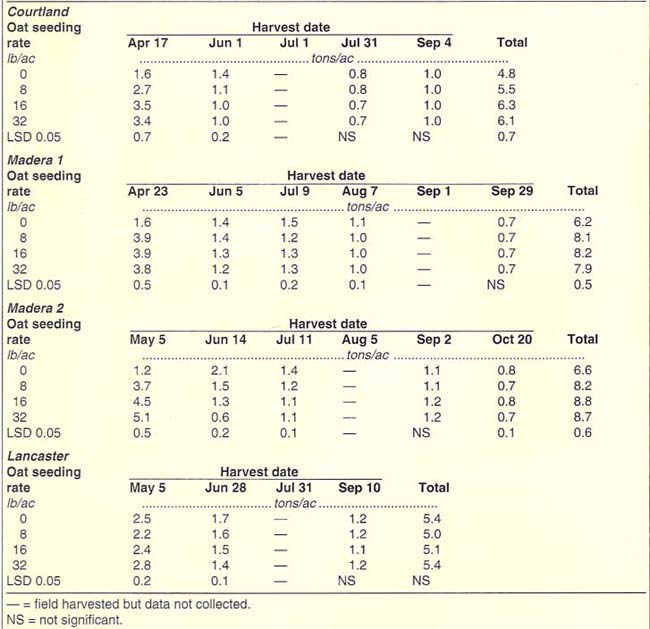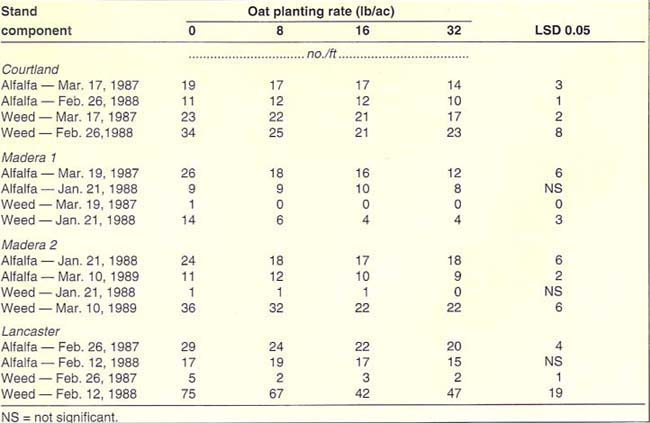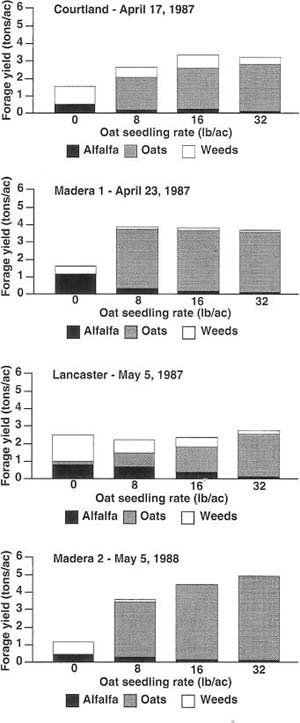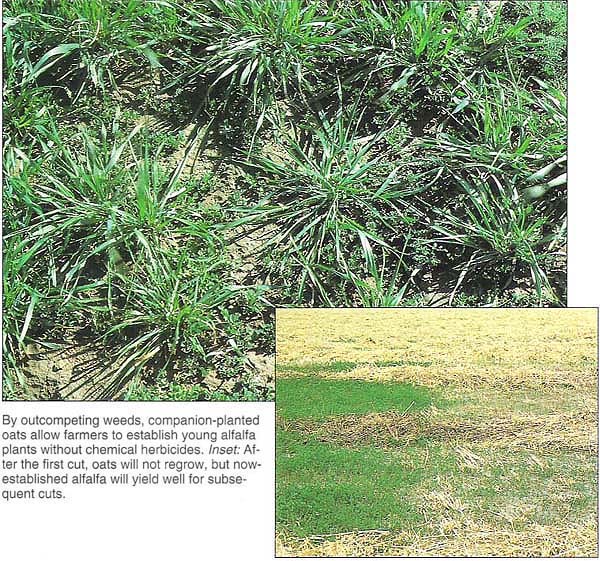All Issues
Fight weeds and increase forage: Using oats as a companion crop in establishing alfalfa
Publication Information
California Agriculture 46(4):25-27.
Published July 01, 1992
PDF | Citation | Permissions
Abstract
During alfalfa stand establishment, an oat companion crop helps fight weeds and can increase first-cutting forage yield, experiments indicate. No long-term negative impacts on alfalfa production were observed.
Full text
Weed control during stand establishment is a critical issue in alfalfa hay production. Weeds can strongly reduce nutritional quality in the first cutting, and by lowering alfalfa density they may reduce yields of subsequent cuttings. Weed seed produced during establishment goes into the soil seed bank, and alfalfa fields with low stand densities are more susceptible to later weed invasions.
Weed control in seedling alfalfa is often unattainable with available herbicides. An oat companion crop can be an alternative to using herbicides; at the same time, it adds to the forage yield during the first year's production. In the Midwest, alfalfa is often established in spring, using an oat companion crop seeded at 50 to 100 pounds per acre (lb/ac). Most areas utilizing oat companion crops are not irrigated, as irrigated companion crops are considered more competitive. Although this practice has been used widely elsewhere, it has not been used in California because of concerns that competition from the oats might reduce alfalfa vigor and stand density.
Experiments were conducted at three locations in California to evaluate the use of an oat companion crop under several sets of growing conditions. The objectives were to assess (1) forage yield, (2) first cutting forage composition and (3) alfalfa and weed densities as influenced by seeding rates of alfalfa and/or an oat companion crop.
Field experiments
Field experiments were established in 1986 at: the high desert (Lancaster, October 9), San Joaquin Valley (Madera 1, November 20), and Sacramento Valley (Courtland, October 27). In 1987, another experiment was established at a second location in Madera (Madera 2, November 4). A split plot design, replicated four times, was used with alfalfa seeding rate (16, 24 or 32 lb/ac) being the main plots and oat seeding rate (0, 8, 16 or 32 lb/ac) being the subplots. Alfalfa cultivars employed varied among sites because of differences in environments. Cultivars used were ‘WL 320,’ ‘WL 515,’ ‘581,’ and ‘GT13 R Plus’ at Lancaster, Madera site 1, Courtland, and Madera site 2, respectively.
‘Curt’ oat, a short-statured, early maturing variety, was planted at each site. Oat was planted using a grain drill at sites established in 1986; at Madera site 2, oat was broadcast and incorporated with a disk to a 2-inch depth. At all sites, alfalfa was broadcast immediately following oat planting and was incorporated with a cultipacker. Experiments were fall seeded and flood irrigated as needed during the growing season.
Number and date of cuttings varied among locations, as did weed species (table 1). Immediately before the first cutting, forage composition and biomass were determined from 1 m2 quadrats.
Harvest dates corresponded to the grower's cutting schedule. Harvests were made using a flail-type harvester that cut a 3- by 20-foot swath from the center of each plot. Alfalfa and weed densities were determined before the first cutting and at the end of each production year.
Result
Alfalfa seeding rates did not influence yields or forage composition at any of the study sites. Therefore, data were averaged over all alfalfa seeding rates at each individual location, and oat seeding rate means were tested for statistical significance.
First cutting yields in the establishment year generally increased with addition of an oat companion crop (table 2). The oat planting rate that gave the highest first-harvest forage yield was 16 lb/ac at Courtland, 8 lb/ac at Madera site 1, and 32 lb/ac at Lancaster and Madera site 2. The forage yield increase associated with an oat companion crop was less at the Lancaster site, compared with other locations, because barley yellow dwarf adversely affected oat productivity.
Yields of subsequent cuttings were reduced by the addition of an oat companion crop; the degree of reduction varied with location and oat seeding rate. Yield reductions ranged from 0.01 to 1.46 ton/ac (table 2). Oats cut after jointing do not regrow; thus, oats were not found in the second or subsequent cuttings. The greatest decline in alfalfa yield following the first cutting occurred in the second harvest at Madera site 2 where the oat crop was planted at 32 lb/ac. Oat growth before the first cutting was extremely vigorous at this location, reducing alfalfa growth and accounting for significant yield reductions in subsequent cuttings. The decline in alfalfa yields associated with the oat crop was less with each subsequent cutting, resulting in no significant difference by the end of the first season. Alfalfa yields in the second year did riot differ among treatments at any location. Total forage yield for the first season was increased at all sites and all oat planting rates, except Lancaster, where oats were hindered by barley yellow dwarf (table 2).
Forage composition of the first cutting was affected by oat seeding rate (fig. 1). Weed biomass represented 31 to 68% of the forage when no oats were used. The use of an oat companion crop at 16 lb/ac reduced the weed biomass by 42 to 91%. An oat crop seeded at 32 lb/ac reduced weed biomass an average of 75%, similar to some herbicide applications made to seedling alfalfa. Weed control was directly proportional to the oat biomass produced at each site Oat growth at Madera site 2 was much greater than at other locations, and the reduction in weed biomass was also greater (fig. 1).
Weed density was reduced by an oat companion crop at all locations in both the establishment and second production years (table 3). The 16-lb/ac oat seeding rate reduced weed density an average of 39 and 46% for the first and second years, respectively. The 32 lb/ac oat seeding rate did not reduce second-year weed density significantly more than the 16-lb/ac seeding rate. The reduction in weed density and growth during establishment probably reduced weed seed production and, in turn, weed populations in the second year.
TABLE 2. Forage yield for individual harvests and seasons in relation to oat seeding rate and location
Alfalfa density during establishment was reduced proportionally by an oat companion crop (table 3). The Courtland location had the lowest alfalfa density in the establishment year, when no oats were planted. A larger weed population at this location than at other sites detrimentally affected alfalfa density (table 3). Madera site 1 was planted later than other sites, perhaps accounting for the large negative impact of oat on alfalfa density there. At the start of the second cutting season, the largest alfalfa densities at Courtland and Madera site 1 occurred following oat seeded at 16 lb/ac (table 3). Results from all locations suggest that oat seeding rates of 32 lb/ac or higher are detrimental to alfalfa densities.
Fig. 1. At all four test sites, weed growth declined consistently with increased oat seeding rates. Though alfalfa growth also declined, the established alfalfa produced well after the oats were removed at the first cut.
By outcompeting weeds, companion-planted oats allow farmers to establish young alfalfa plants without chemical herbicides. Inset: After the first cut, oats will not regrow, but now-established alfalfa will yield well for subsequent cuts.
Conclusion
An oat companion crop was found to be an effective alternative to chemical weed control in seedling alfalfa. In general, oat replaces weeds in the first cutting and total forage yields are increased. The oat companion crop did reduce alfalfa stand densities before the first cutting, but stand measurements in the beginning of the second production year indicated no detrimental affect on stand from either 8- or 16-lb/ac oat seeding rates. The 16-lb/ac oat seeding rate was optimum for maximum alfalfa stand density, weed control, and seasonal yield. Higher oat seeding rates did not increase seasonal yield and detrimentally affected the alfalfa stand. Growers may wish to experiment to determine the optimum oat seeding rate for their climates, alfalfa cultivar, and planting date to maximize yields and minimize the negative effects of oat competition.
An oat companion crop may not be advisable under conditions that favor growth of oat over that of the alfalfa. An example of this would be cooler climates where more dormant alfalfas are grown (for example, the Lancaster site). Oat continues to grow over winter, whereas alfalfa growth is minimal. The same may be true for late planting dates when cooler weather is not conducive to alfalfa growth and the growth of oats is favored (for example, Madera site 2).
This practice provides growers with a means for increasing forage production in an alfalfa establishment year. Oat or alfalfa/oat hay is a suitable feed for all livestock, with the exception of lactating cows, which require pure alfalfa for maximum milk production. Additionally, it provides growers with another weed control. Bromoxynil (Buctril) can also be used for additional broadleaf weed control, as it is labeled for both oats and alfalfa. In most growing areas of California, using an oat companion crop during alfalfa establishment is a viable, economic option.









